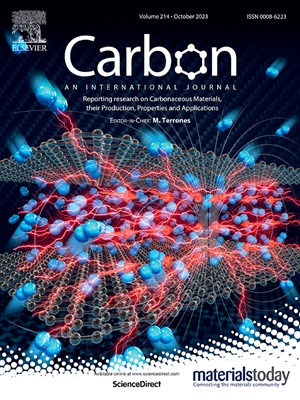介电协同梯度超材料可实现卓越的超宽带微波吸收和抗菌特性
IF 10.5
2区 材料科学
Q1 CHEMISTRY, PHYSICAL
引用次数: 0
摘要
本文章由计算机程序翻译,如有差异,请以英文原文为准。
Dielectric synergistic gradient metamaterials enable exceptional ultra–wideband microwave absorption and antibacterial properties
Interface structure design and multi–component strategies for regulating electromagnetic parameters to achieve efficient microwave absorption remain a challenge. In this study, a composite film with a heterogeneous structure, PAN@PPy@Ti3C2Tx@GO (PPTG) was fabricated through electrospinning, in situ oxidative polymerization, and dip–coating processes, achieving excellent electromagnetic wave absorption and antibacterial properties. When the filler content is only 20 wt%, the PPTG film exhibits an ultra–wide bandwidth, with a minimum reflection loss value (RLmin) of −49.98 dB (2.2 mm, 16.72 GHz), and the maximum effective absorption bandwidth (EAB) reaches 8.0 GHz (2.5 mm). The outstanding absorption performance is attributed to quarter–wavelength theory, polarization, multiple reflections and scattering, impedance matching, metamaterial properties, quasi–antenna effect, conductive loss, and magnetic loss. Excitingly, the radar cross–section (RCS) of the PPTG film can be reduced by up to 25.72 dB•m2, indicating excellent radar stealth properties. Moreover, the PPTG film exhibits excellent antibacterial properties. This research, based on the MXene absorber, provides new insights into the development of lightweight, efficient, and antibacterial microwave–absorbing materials.
求助全文
通过发布文献求助,成功后即可免费获取论文全文。
去求助
来源期刊

Carbon
工程技术-材料科学:综合
CiteScore
20.80
自引率
7.30%
发文量
0
审稿时长
23 days
期刊介绍:
The journal Carbon is an international multidisciplinary forum for communicating scientific advances in the field of carbon materials. It reports new findings related to the formation, structure, properties, behaviors, and technological applications of carbons. Carbons are a broad class of ordered or disordered solid phases composed primarily of elemental carbon, including but not limited to carbon black, carbon fibers and filaments, carbon nanotubes, diamond and diamond-like carbon, fullerenes, glassy carbon, graphite, graphene, graphene-oxide, porous carbons, pyrolytic carbon, and other sp2 and non-sp2 hybridized carbon systems. Carbon is the companion title to the open access journal Carbon Trends. Relevant application areas for carbon materials include biology and medicine, catalysis, electronic, optoelectronic, spintronic, high-frequency, and photonic devices, energy storage and conversion systems, environmental applications and water treatment, smart materials and systems, and structural and thermal applications.
 求助内容:
求助内容: 应助结果提醒方式:
应助结果提醒方式:


